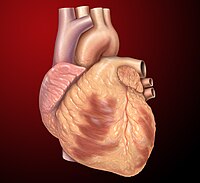
Photo from wikipedia
Acute myocarditis (AM) is commonly found in everyday clinical practice. Differential diagnosis between various causes of myocardial damage with non-obstructive coronary arteries can be cumbersome for clinician. Moreover, AM may… Click to show full abstract
Acute myocarditis (AM) is commonly found in everyday clinical practice. Differential diagnosis between various causes of myocardial damage with non-obstructive coronary arteries can be cumbersome for clinician. Moreover, AM may be provoked by a number of different causes and clinical presentation can be heterogeneous with potential overlap going from asymptomatic or subclinical to severe heart failure, arrhythmias, and death. Cardiac magnetic resonance (CMR) over the last decades has proven to be the diagnostic technique of choice since it allows identifying AM with excellent diagnostic accuracy. Latest technological advancement with parametric imaging such as T1 and T2 mapping further increases sensitivity and provides additional help towards a correct diagnosis. CMR however is no longer to be considered as a mere diagnostic tool but also as a powerful source of prognostic information. Scientific evidence has corroborated CMR’s role beyond diagnosis demonstrating how late gadolinium enhancement (LGE) presence is a powerful predictor of cardiac events and how the presence of septal LGE is to be considered of worst prognosis regardless of LGE extension even in patients with preserved global systolic function. CMR should be routinely performed in all patients with AM suspicion since its diagnostic and prognostic role is of paramount important and could modify therapeutic strategy and subsequent clinical decisions.
Journal Title: Heart Failure Reviews
Year Published: 2018
Link to full text (if available)
Share on Social Media: Sign Up to like & get
recommendations!